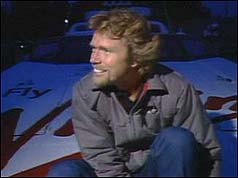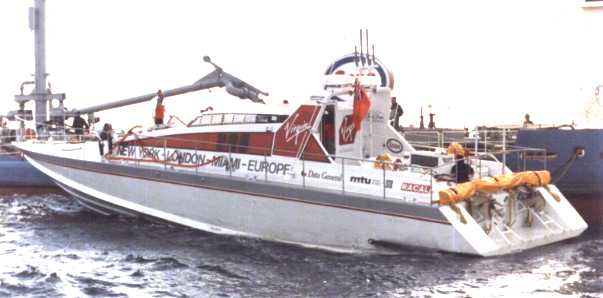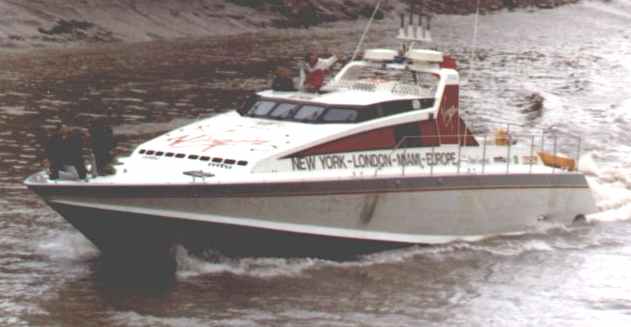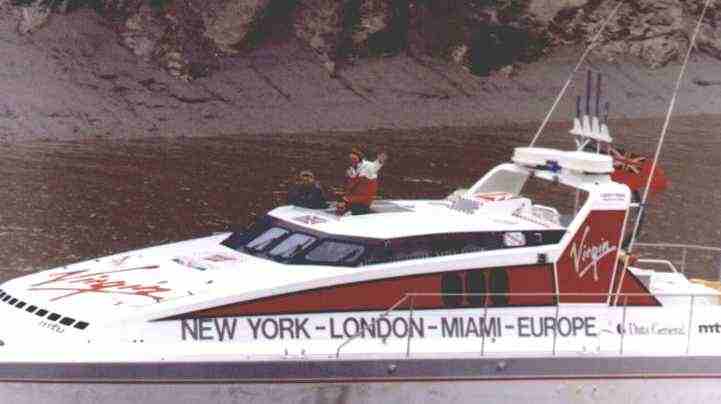|

Sir
Richard Branson isn’t just a guy with a beard and a
penchant for sweaters, balloons and boat racing.
He’s also the man behind one of the most successful
brands in the world: Virgin. But then you probably knew
that already.
Richard
Branson is synonymous with Virgin – and this isn’t
an accident: “If you get your face and your name
out there enough, people will start to recognise you.
Many people know the Virgin brand better than the names
of the individual companies within the group. A young
girl once came up to me and told me I could be famous
because I looked just like Richard Branson. Branding is
everything.”
Of
course, there’s more to Richard Branson than Virgin,
although for most people this would probably be enough.
But then, Richard Branson is not most people. He’s a
man who likes a challenge, whether it’s in business or
pleasure. On top of being knighted for ‘services to
entrepreneurship’, he has been involved in a number of
world-record breaking attempts.
“My
first success was in 1986 with my boat “Virgin
Atlantic Challenger II”. I wanted to rekindle the
spirit of the Blue Riband by crossing the Atlantic Ocean
in the fastest ever recorded time.” A year
later, he crossed the same ocean, this time in a hot air
balloon. The "Virgin Atlantic Flyer" was not
only the first hot-air balloon to cross the Atlantic but
was also the largest balloon ever at 2.3 million cubic
feet.

Virgin
Atlantic Challenger II being re-fuelled 10 miles off
Halifax in 1986
The
Blue Riband was established by shipping magnates in 1838
as an informal competition. Richard Branson broke
the record, but the Hales' trustees refused to award him
the trophy because his boat did not have a commercial
maritime purpose and he had stopped to refuel.
The
SS United States' record was not broken until 1990, when
the 74m (243ft) catamaran Hoverspeed Great Britain
completed the crossing with an average speed of 36.65
knots. In 1987 Mr Branson abandoned the sea and
took to the air. His Virgin Atlantic Flyer hot air
balloon was the first to cross the Atlantic that year,
and in 1991, he broke the Pacific record by crossing
from Japan to Arctic Canada.
Richard
Branson's first attempt to cross the Atlantic in 1985
followed the launch of his Virgin Atlantic
airline. The voyage was a failure, his boat
sinking off Land's End, but his second attempt the
following year brought him recognition and publicity.
But
he was denied the Blue Riband by the trustees of the
award because he had broken two rules of the competition
- he had stopped to refuel and his vessel did not have a
commercial maritime purpose. The SS United States'
record was not broken until 1990, when the 74m catamaran
Hoverspeed Great Britain completed the crossing with an
average speed of 36.65 knots.

Length
over all - 72 feet Hull - Aluminum
26
June 1986: Branson on course for Blue Riband
Entrepreneur
Richard Branson set off on his second attempt on the
26th June 1986 to claim the transatlantic crossing
record for Britain. Mr Branson and his team left
New York at dawn on their 72 ft powerboat Virgin
Challenger II for the 3,000 mile (4,828 km)
voyage. If they reach Bishop's Rock, off the Isles
of Scilly, by 2100 BST on 29 June they will recapture
the Blue Riband for the UK - held by liner SS United
States since 1952 for a crossing in three days and 10
hours.
The
millionaire businessmen tried to break the record last
year, but his boat sank just 138 miles (222 km) from the
British coast. Mr Branson told the BBC he was
confident they would succeed this year. "The
boat's ready, the crew are ready and the weather
forecast is reasonable - hopefully we'll be there for
Sunday lunch," he said.
A
spokesman at the Virgin Challenger London headquarters
said the team had almost reached Nova Scotia for the
first of three refuelling stops at 2100 BST and was two
hours ahead of schedule. After taking on more
fuel, the £1.5m boat will head across the ocean on the
"great circle" route - the quickest course
across the Atlantic.
BBC
Tomorrow's World presenter Peter Macann is on the
Challenger and said conditions had been perfect for the
first stage of the voyage. "The only point of
excitement was when I was driving and a whale surfaced
about 50 m (164 ft) from the boat - I just managed to
swerve to avoid it," he said.
29
June 1986: Branson beats Atlantic speed record
Millionaire
Richard Branson today smashed the world record for the
fastest crossing of the Atlantic. His 72-ft powerboat,
the Virgin Atlantic Challenger, reached the Bishop Rock
off the Isles of Scilly just after 1930BST. Mr
Branson completed the voyage more than two hours faster
than the previous record-holder, the SS United States,
which has held the title since 1952. The
Challenger's successful crossing came in spite of
problems with the fuel system.
Her
voyage was closely monitored from an operation room in
London, where tension mounted as the £1.5m powerboat
headed for the finishing line at more than 50 knots. Mr
Branson's voice was relayed over the radio, keeping the
team up-to-date on his progress.
It
took the Challenger one hour from the finishing line to
reach the island of St Mary's, where crowds were waiting
in their hundreds in spite of the pouring rain.
After three days at sea, Branson, the head of a
multi-million-pound airline and record empire, arrived
triumphant - before being pushed into the Atlantic by
his crew for a joke.
In
London the champagne flowed, but it is still not certain
whether the team will be able to claim the Blue Riband,
the trophy awarded to the American boat in 1952.
The prize currently resides in a New York maritime
museum, and the final decision on the Challenger's claim
appears to lie with the museum and trustees of the
trophy.
| |
|
|

Virgin
Atlantic Challenger II - Richard Branson waving
THE
AGA KHAN - TACKLES VIRGIN CHALLENGER RECORD
Destriero
is the ultimate big boy's toy, with 54,000bhp and sexy
Italian styling. Next month it will attempt to snatch
the Blue Riband for the fastest Atlantic voyage.
Corporate sponsors' names decorate its deck; but who
owns it?
It's
all Richard Branson's fault. The record for the
fastest sea crossing of the Atlantic, the Blue Riband,
had been held for more than 30 years by the SS United
States, the last of the great high-speed liners. The
liner itself lay mothballed in the harbour at Norfolk,
Virginia; its owners had gone out of business; and the
Hales Trophy which it won was gathering dust in the
American Merchant Maritime Museum. Despite one
American team's attempts on the record in the
Seventies, interest in the fastest transatlantic ship
had dwindled. Nobody cared because everybody flew.
But
Branson wanted everybody to fly on his new airline,
Virgin Atlantic. So in 1985 he set out to take the
Blue Riband in the Virgin Atlantic Challenger
powerboat and to generate publicity for the airline.
He failed in the first objective (the boat sank 138
miles off Land's End) but succeeded magnificently in
the second, with the result that a queue of contenders
for the Blue Riband began to form. Branson tried again
(this time successfully), and was followed by the
American millionaire Tom Gentry, who also had two
attempts; Hoverspeed's Sea Cat made the crossing,
Italy's Azimut Atlantic Challenger failed to do so,
and earlier this month the French boat, Jet Ruban
Bleu, turned up in New York for its second attempt.
And as the contenders multiplied, so did the prizes:
there are now four different trophies for the fastest
Atlantic crossing.
The
most powerful challenge for the Blue Riband since its
revival will come from the Italian vessel Destriero,
which next month aims to take all four trophies by
breaking the record in both directions across the
Atlantic. The power does not come merely from its
54,000bhp engines. Behind Destriero's challenge are
the Aga Khan, Fiat's Giovanni Agnelli and the
presidents of Italy's state-owned industrial holding
company, IRI, and its Olympic committee. The all-white
boat is decorated with the logos of Fiat, the petro-chemical
giant Agip, Ciga Hotels and the Meridiana airline
(both controlled by the Aga Khan), and the
nationalised shipyard, Fincantieri, which built
Destriero. Together with other sponsors they have
invested $12 million in the challenge -- and that
excludes the cost of the vessel.
For
the last month Destriero has been undergoing trials at
its home port of Porto Cervo on Sardinia's Costa
Smeralda, the holiday resort developed by the Aga
Khan. Moored initially near the clubhouse of the Yacht
Club Costa Smeralda (president: the Aga Khan), under
whose flag it has entered the Atlantic challenge, the
67-metre, 400-ton vessel dominated the small bay.
Early-season holiday-makers gathered on the quayside
to look at it, buzzed around on jet-skis and in
dinghies, bought spin-off merchandise with the
Destriero badge (polo shirt L40, wind-cheater L75) or
simply gazed across the bay at the high-tech
apparition. "Look at that yacht," said an
astonished young girl as she caught her first sight of
it. "That's not a yacht, it's a ship,"
replied one of her friends scornfully.
They
were both right. Cesare Fiorio, the 52-year-old former
sporting director of the Ferrari Grand Prix team who
has masterminded the Destriero challenge, takes pains
to distinguish it from the other challengers of the
Branson generation: "It's not a powerboat, it's a
sea-going ship". But the brass plaque issued by
Det Norske Veritas, which classifies vessels for
insurance purposes, describes it as a "Gas
Turbine Yacht". Destriero calls itself "a
steed or war horse" (the English translation of
the name), but anybody who thought it was an aeroplane
wouldn't be far from the truth: it has three General
Electric aero engines, while an FA-18 Hornet jet
fighter gets by with only two.
One
could just hear the rising whine of the turbines up on
the bridge, set high in a superstructure styled by
Pininfarina, Ferrari's designer, as Destriero was
towed out of the marine by a tug. But the loudest
noise was the hum of the computers. A total of 16
screens display information from the two on-board
computer systems. One of them controls the engines and
the three water-jets; the other is for navigation, and
is so sophisticated that it not only guides the vessel
along a predetermined transatlantic route but also
warns of obstacles like ships and buoys (the former at
a distance of 96 miles) and even suggests ways of
avoiding a collision.
On
a short trip along the Sardinian coastline, the
closest we got to a collision was with the tug, which
radioed Destriero to slow down until it had got out of
the way. Thereafter, all was peace and quiet: on an
almost completely flat sea, Destriero accelerated to
59 knots -- just short of its maximum speed but still
almost 70mph -- with about as much drama as an
Intercity train leaving Euston. Down below, fuel was
being sucked out of the 740-ton tank and into the
turbines at the rate of 8000 litres per hour; but up
on the bridge most of the 14-man crew in their
corporate sport outfits just wandered from one
suede-look chair to another, and the rest of us
watched the sea slide past and wondered why
cross-channel ferries make such a fuss about doing 22
knots.
The
technology of Destriero is not new - its aluminium
hull, gas turbines and integrated navigation system
are already familiar marine features -- but it is
being tested beyond the known limits because, as
Fiorio says, "nobody has ever done 65 knots in a
67-metre vessel before". He is confident that
"although sea navigation has not developed to the
same extent as cars and aeroplane in the last 50
years, Destriero's philosophy will be adopted for
high-speed, 45-knot ships in the near future".
The Fincantieri shipyard has, Fiorio says, already
designed a ferry for the Sardinian crossing which
would be capable of that speed while carrying 400
passengers and 150 cars. He is equally confident that,
barring misfortune or very bad weather, Destriero will
break the records, both on the crossing from Gibraltar
to New York and the more familiar, shorter voyage back
to the Scilly Isles. "The first 10 to 15 hours
will be critical: with a full fuel load, the vessel
floats much lower in the water, and in bad weather the
waves break right across it".
But
whether Destriero will take all the available prizes
is a matter for lawyers rather than mariners. The
Virgin Atlantic, Daily Mail and Columbus Atlantic
trophies (for, respectively, the fastest crossing, the
fastest crossing without refuelling, and the fastest
return crossing, again without refuelling) pose no
problem. Nor does the Blue Riband, which was never a
formal competition and therefore has no rules and no
trophy. The difficulty lies with the Hales Trophy,
first presented in 1935 by Harold Keats Hales, MP for
Hanley. The premier award for the transatlantic
crossing and now commonly regarded as the symbol of
the Blue Riband, it is currently held by the
Hoverspeed Great Britain Sea Cat with a time of 79
hours and 54 minutes; it was not given to the Branson
generation of powerboats (although Tom Gentry's
fastest-ever crossing took 17 hours less than the Sea
Cat) on the grounds that specially-built vessels which
had to be refuelled en route were not in keeping with
the spirit of the trophy, which was originally
intended for high-speed liners.
"For
Destriero" says Fiorio, "the problem is the
requirement that the Hales Trophy can only be awarded
to a ship which ultimately has a commercial use: it
must be operated by a sea transportation company to
carry passengers or freight. The trustees asked us to
make a declaration that Destriero would have a
commercial use; if we didn't, we would not get the
trophy".
In
early May, Fiorio had still not decided what to do.
"It's not up to us what happens to the vessel
afterwards, it's up to the owners. And we don't know
what they want to do with it". So who are the
owners of the Destriero, valued by some people at $50
million? Fiorio wasn't saying: "We don't know, we
just run the ship", he replied with a smile and
shrug that made it clear that anybody who did want to
know would have to find out for themselves.
Surreptitious
questioning elsewhere led to a tip that the ship was
controlled by an Irish company called Bravo Romeo.
(The name is the call sign for the letters 'B' and 'R'
which presumably stand for Blue Riband.) A company
search revealed that 99 per cent of its shares are
held by a Swiss-based company, and the two American
designers of Destriero are among its directors.
Connections with a familiar name began to crop up. The
remaining 1 per cent of the shares are held by a
senior official in the secretariat of the Aga Khan;
the third director, a lawyer, is also a director of a
British company associated with the Aga Khan.; the
Notes to the Financial Statements record that in the
year ended November 1989, the company owed $1,282,715
on a loan account to...the Aga Khan.
Finding
out what the owners of Destriero propose to do with it
after the attempt on the Blue Riband shouldn't be too
difficult for Fiorio. He probably only has to pop into
the yacht club and ask its president.
Richard
Branson's Open Letter (and picture!) to Qantas CEO
Geoff Dixon
Sir
Richard Branson is a genius at scoring public
relations coups.
His
open letter to Geoff Dixon creates a spectacular
'win-win' for Branson (and perhaps a lose-lose for
Dixon!).
Whatever
now happens, the certain result is that Branson will
earn substantial more publicity for himself and his
airline, in the 'underdog' role that he portrays so
well.
|
Flamboyant
Sir Richard Branson founded Virgin Atlantic
Airways in 1984. In 2000, he started a
new airline in Australia - Virgin Blue.
At
the time of Virgin Blue's conception, there
was a fair measure of skepticism within
Australia as to whether it would be possible
for what would have become a third Australian
airline to survive. Several earlier
attempts by other would be competitors to the
two established airlines (Qantas and Ansett)
had all ended in ignominious failure. Of
course, Qantas did all it could to discourage
and disparage its new competitor.
Nonetheless,
Virgin Blue proceeded, and then, more or less
fortuitously perhaps, Ansett (owned by Air New
Zealand) went bankrupt, and Virgin Blue
suddenly found a market that was reasonably
full of air service change to a market where
40% of all flights had suddenly ceased.
Partly because of that, and partly because it
is a good airline anyway, Virgin Blue
now appears to be flourishing.
Flash
forward to 2003. Virgin Atlantic have
often stated their desire to be able to
operate flights to Australia, and their
interest has again surfaced to the point where
they're aggressively planning to start such
flights (if they can get permission from the
Australian government!).
Qantas
has again been understandably disparaging
about this - for sure, Qantas would very much
prefer not to see another major competitor on
its 'Kangaroo Route' (ie London-Sydney).
And
so, with this as background, please enjoy the
following open letter from Sir Richard to
Geoff Dixon, CEO of Qantas.
Sir
Richard Branson
24 July 2003
OPEN
LETTER TO GEOFF DIXON FROM RICHARD BRANSON
Dear
Geoff,
I
was amused to read Qantas’s completely
dismissive comments about Virgin Atlantic’s
chances of getting permission to fly to Australia. It would be prudent for you
to remind yourself of your and James
Strong’s equally dismissive comments about
Virgin Blue’s chances of entering the
Australian market only three years ago.
Here
goes! This is the gist of what you said:
-
“Virgin
Blue is a lot of media hype.”
-
“This
market is not big enough to sustain Virgin
Blue.”
-
“Virgin
Blue doesn’t have deep enough pockets to
cope.”
-
“Qantas
will employ any option to see off this
interloper.”
-
“They’ll
be unlikely to survive a year.”
-
“Claims
by Richard Branson that domestic fares are
high are a misnomer!” (my exclamation
mark)
Here
is what James Strong, your former C.E.O, said
about Virgin Blue and myself:
“If
you listen to most of the pretenders there
is a distinct air that they are making it up
as they go along. In terms of real plans and
real commitment you could fire a shot gun up
the main street and not hit anybody.”
Yet
three years later you are telling your staff
that this same airline, “that was making it
up as it went along” and that now has 30% of
the market could, “Drive Qantas out of
business!” We also find it flattering, if a
little silly, that three years on you now have
spies hiding behind pot plants in the Virgin
terminal trying to work out why we are so
successful.
Even
if some of your comments don’t suggest it,
your actions indicate you are taking us
seriously. But let’s not take ourselves too
seriously. I would like to propose a friendly
challenge!
If
Virgin Atlantic fails to fly to Australia
(within 18 months, say) I’d be prepared to
suffer the indignity of donning one of your
stewardesses brand new designer outfits and
will work your flight from London to Australia
serving your customers throughout.
However,
if Virgin Atlantic does fly to Australia you
would do so instead. On our inaugural flight
from London to Australia you would wear one of
our beautiful red Virgin Stewardesses uniforms
and serve our inaugural guests all the way to
Australia. Oh and in case you were
wondering, we’re not hung up on flying
through Hong
Kong. You might end up doing your
days work experience through Singapore,
Thailand or Malaysia instead.
This
is the challenge. If you believe in what
Qantas said to the press there can’t be any
risk for you. We expect your response within
one week. Our inaugural flights are great fun
and I look forward to welcoming you on board
personally. Oh and by the way my preferred
drink is ………..!
Kind
regards,
Richard.
p.s.
I enclose a picture to give you an idea of
what you might look like.

Dixon
wasn't impressed with Branson's offer.
"We
are running an airline not a circus,"
Dixon said through a Qantas spokeswoman.
|

Global
warming has unexpected consequences for competing groups
of scientists
each
wanting to take credit for themselves
for the
find of the century.
This
short story is being developed for release as a
full length novel (e-book)
for
2015 with storyboards
for a film in 2016
of ASAP thereafter.
|




